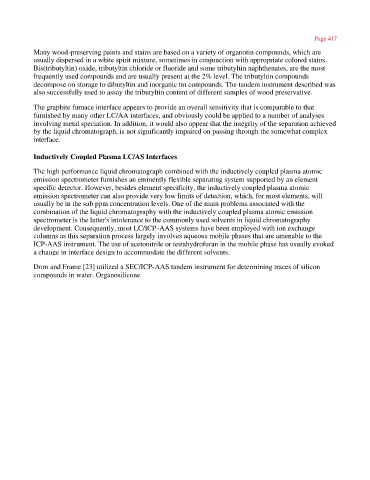Page 434 - Tandem Techniques
P. 434
Page 417
Many wood-preserving paints and stains are based on a variety of organotin compounds, which are
usually dispersed in a white spirit mixture, sometimes in conjunction with appropriate colored stains.
Bis(tributyltin) oxide, tributyltin chloride or fluoride and some tributyltin naphthenates, are the most
frequently used compounds and are usually present at the 2% level. The tributyltin compounds
decompose on storage to dibutyltin and inorganic tin compounds. The tandem instrument described was
also successfully used to assay the tributyltin content of different samples of wood preservative.
The graphite furnace interface appears to provide an overall sensitivity that is comparable to that
furnished by many other LC/AA interfaces, and obviously could be applied to a number of analyses
involving metal speciation. In addition, it would also appear that the integrity of the separation achieved
by the liquid chromatograph, is not significantly impaired on passing through the somewhat complex
interface.
Inductively Coupled Plasma LC/AS Interfaces
The high performance liquid chromatograph combined with the inductively coupled plasma atomic
emission spectrometer furnishes an eminently flexible separating system supported by an element
specific detector. However, besides element specificity, the inductively coupled plasma atomic
emission spectrometer can also provide very low limits of detection, which, for most elements, will
usually be in the sub ppm concentration levels. One of the main problems associated with the
combination of the liquid chromatography with the inductively coupled plasma atomic emission
spectrometer is the latter's intolerance to the commonly used solvents in liquid chromatography
development. Consequently, most LC/ICP-AAS systems have been employed with ion exchange
columns as this separation process largely involves aqueous mobile phases that are amenable to the
ICP-AAS instrument. The use of acetonitrile or tetrahydrofuran in the mobile phase has usually evoked
a change in interface design to accommodate the different solvents.
Dorn and Frame [23] utilized a SEC/ICP-AAS tandem instrument for determining traces of silicon
compounds in water. Organosilicone

